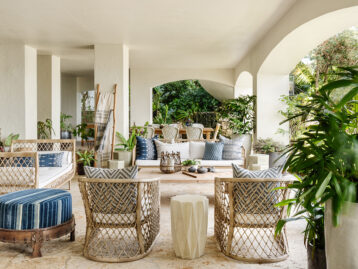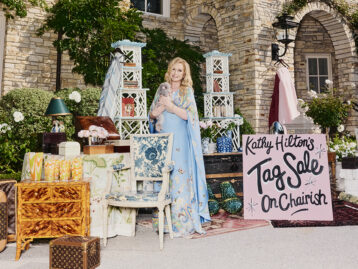For over 30 years, Stamford-based Greenwich Living has been serving designers and tastemakers throughout the country. After getting their start sourcing one-of-a-kind Maison Jansen furniture, the team at Greenwich Living expanded to focus on 19th-century French designs and an array of 20th-century works. Founder Sam Pizzichillo and his son Nicholas, who serves as gallery manager, have helped the business flourish over the years, including during a recent move to a larger space (all during a pandemic, mind you).
We spoke with both Sam and Nicholas about the evolution of their business and the trends they’re seeing now — as well as the ones they’d actually like to see go away. Read on for the spirited discussion below, and be sure to shop their diverse assortment on Chairish.
Shop Greenwich Living
Product_id 1448083 not found
Product_id 3425574 not found

Greenwich Living has been around for over 30 years. First and foremost, how did you launch the business?
Sam Pizzichillo: The business was launched out of necessity, actually. I originally worked for my father at a small antiques company as a buyer and appraiser. In the early 1990s, I started to sell goods on a retail basis in Stamford, and we’ve grown from there.
This summer you moved into a new space in Stamford… tell us all about it.
Nicholas Pizzichillo: The space totals 22,000 square feet across two floors with top-of-the-line finishes. The main gallery is filled with natural light, fitted with a tan and grey palette, floating shelves, and gallery art walls. Raw birchwood platforms are scattered throughout the gallery on both the first and second floor to highlight some of the most important works on display.
Shop Greenwich Living
Product_id 2184558 not found

Connecticut (and Stamford in particular) has seen a ton of growth over the last year and a half. How has that affected business, and the area itself?
NP: The exodus from our old location was actually prompted by the fact that the landlord had made the decision to knock down the building to begin construction of a residential apartment complex. The changing Stamford landscape was single-handedly the reason our business was turned on its head and ultimately forced us to find a new home — in the middle of a global pandemic. It was daunting, but nevertheless, we’re convinced it was a blessing in disguise. Our new gallery space is exceptionally nicer than our previous home and we’re now flanked by two fantastic brands: Stark Home and Holly Hunt. We’re seeing more organic traffic from our neighbors than ever before. Business continues to be incredible.
SP: To be honest, the growth in Stamford itself hasn’t really affected our business. What has is the pandemic-induced shortage of purchasable goods — and its impact on lead times. Our business has increased almost 100% this year over last year, which was already a good year to begin with. At Greenwich Living, goods can be delivered in one week if need be, and our clients appreciate that.

How did you pivot the business during the pandemic, and how have things rebounded since? How has sourcing been this time?
NP: This industry slowly but surely had begun to go digital years before the pandemic. We do extremely well virtually through our own platforms as well as marketplaces like Chairish. The pandemic forced a moment of reflection. Our entire virtual footprint underwent a facelift. We revamped our website, more aggressively turned to Instagram, reviewed where our marketing dollars were going, and even revised a lot of our branding and marketing materials. Hence the new name — Greenwich Living Design, formerly Greenwich Living Antique and Design Center.
SP: Given our decades of business contacts, we’ve been one of the lucky ones when it comes to sourcing, which has been difficult in every area. I have contacts that curate goods for me on a weekly basis, so the pandemic really hasn’t hurt us. When we were locked down, we remodeled our space and built our inventory, waiting for a big reopening. Little did we know that the redecorating and revamping would go to waste following the news that the building was being demolished!
Shop Greenwich Living
Product_id 3154507 not found
Product_id 2928562 not found

Have more customers been coming in through virtual methods like Chairish in the last year? Do you see that having an effect on the way designers shop for vintage and antique pieces in particular?
NP: Yes – through both online marketplaces like Chairish as well as our social media efforts. Designers are scrolling through Instagram and sellers’ storefronts online more than ever before. The way people shop in general has drastically changed. I continue to believe that experiencing vintage and antique pieces in person will continue to be the best way to convert sales. It’s like art.
SP: Our online sales remain on track with previous years. We’ve also seen a slight increase in traffic via the gallery itself.
You focus on 18th- to 20th-century pieces, with a special focus on 19th-century French designs and quintessential 20th-century works. What are some of your favorites within those categories?
SP: While I have developed a love of antiques, especially 19th-century French designs, I’ve moved away from those specifically due to the influence of my son Nicholas. It became quite apparent that mid-century modern, Hollywood Regency, and Deco have taken over the landscape. The likes of Maison Jansen, Jeanneret, Evans, and any mid-century or Hollywood Regency names are at the forefront now.
Shop Greenwich Living
Product_id 2877191 not found

What type of items have been moving this year?
NP: Black-and-gold traditional Hollywood Regency style home furnishings and decor continue to sell well for us. Aside from the norm, we’re moving more modern pieces than ever before. Mid-century works consistently draw a ton of interest. I think with extended lead times and production delays due to COVID, people are truly appreciating the value some vintage flair can bring to a space. That’s aside from how seamless the purchase process can be when you’re not worried about manufacturing delays.
SP: There’s definitely a great deal of mid-century modern and modern pieces selling, as I mentioned. However, our loyal collectors of French and English antiques still make purchases.
What are some of the trends you’ve seen in terms of the things people are collecting? What do you think will be next?
NP: Collecting and flipping in general has exploded over the past year during the pandemic. Sports cards are a great example of this, fetching record-breaking numbers at auction this past year. I think people are realizing there are other investment-grade opportunities out there — that collecting fine art isn’t the only place to put your money in the world of collectibles. With people at home and with so much time on their hands, it was easier than ever to hop on a computer and explore. Investing in the objects in your interior can provide functionality and enjoyment over the years along with a financial return in the long run.
SP: While French Deco and Hollywood Regency are the hot, in-demand items at the moment, I do think there will be a return to Old World charm in the future. If you want to stay ahead of the curve, it doesn’t make sense to wait for the resurgence of any particular style or item. We serve the public and provide goods of all styles at the fairest prices.
Shop Greenwich Living
Product_id 3347137 not found

Are there any styles or trends you’d like to see disappear in the design world right now?
NP: Ultra-minimalist spaces. Sometimes less is more, but the bare minimum isn’t always the answer. Pops of maximalism will begin to make a splash in more contemporary homes; it’s just a matter of time.
SP: It’s our belief that lower-end goods, copies, and modern goods that try to look like the originals should disappear. Construction with no quality that’s focused only on price should be removed from the market. I often see large companies selling brand-new pieces that have astronomical prices simply because they look like Jansen or Jeanneret or the like.
You have access to so much beautiful design at Greenwich Living, but what’s a dream piece you’d love to have for yourself?
SP: I’ve never dreamed of owning one particular piece — I dream about world peace instead! In reality, I’m a fan of high-quality construction, like with Francois Linke, Maison Jansen, Baques, and Louis XVI.
Anything else that you think would be particularly interesting for our audience?
NP: I think the design industry is in a very interesting state right now. Virgil Abloh is doing furniture. Daniel Arsham is doing furniture. Kourtney Kardashian is writing about Pierre Jeanneret on her blog, Poosh. A fashion designer just created a postmodern icon in the Roly Poly chair. Instagram influencers are posing on their DS-600 sofas all over my Explore page. Design is transcending age, race, gender, and careers. Design is engrained in the culture of today. Vintage is cool. People are once again going to find that cool factor in historical design. We’re positioning our brand to be at the forefront of this movement. After all, at what gallery can you find a Henry Dasson commode, Gio Ponti double dresser, and Francois Linke case pieces surrounded by Jeanneret dining chairs, Italian lounge chairs in sheepskin, and art from the early 2010s? That’s diversity.
SP: I’d want people to know that Greenwich Living Design has a lifetime guarantee policy. Any item can be returned for a full credit to purchase at any time, no questions asked. We excel at making the customer part of our family, and never let any client walk away unhappy. Having made some seven figures in sales on Chairish, we’ve never disallowed a return or had a dissatisfied customer. We’re a business that has thrived in the toughest of times and we’re expanding. And my son Nick has truly established himself as an incredibly informed and up-to-date curator of fine goods.
All images courtesy of Greenwich Living































